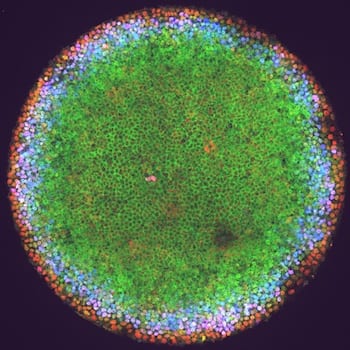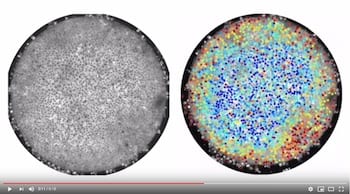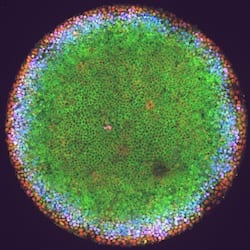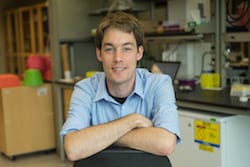NEWS RELEASE
Editor’s note: Links to video and high-resolution images for download appear at the end of this release.
David Ruth
713-348-6327
david@rice.edu
Mike Williams
713-348-6728
mikewilliams@rice.edu
Embryos’ signals take multiple paths
Rice University scientists find differentiating cells do not all respond the same when told to change
HOUSTON – (March 7, 2019) – Rice University scientists have found significant differences between the methods signaling pathways use to prompt cells to differentiate – that is, whether to become organs, bone, blood vessels, nerves or skin.
Rice bioscientist Aryeh Warmflash and alumnus Idse Heemskerk led a team that discovered stem cells are sensitive not only to the signals that form the “instructions” to create the pattern of the organism, but to how rapidly those signals are delivered.
A videoshows the Nodal wave moving inwards as cells differentiate en route to their ultimate fates in an organism. The image shows the activated SMAD4 proteins in the nuclei of cells, tagged with green fluorescent proteins that allowed Rice University bioscientists to monitor them. The right image shows the same cells, color-coded by the strength of their signals. Video courtesy of the Warmflash Lab
The lab set out to see if the amount of the signaling molecule was the primary cue for instructing the cells what to become.
The answer was clearly “no” for one of the highly related pathways they studied – and, surprisingly, “yes” for the other.
The open-access paper in eLife details the activities of two signaling pathways, Nodal and BMP4, in experimental models of early mammalian embryos.
Both pathways are integral to the process known as gastrulation, when the body plan of the embryo is created. BMP4 triggers the process and defines the “ventral” or belly side of the embryo, where skin will form. On the opposite side, where BMP is low, the nervous system develops. When cells are exposed to BMP, it sustains change for as long as its triggering ligand is present.
In contrast, the Nodal pathway, which causes cells to become muscle, the heart and other organs, is controlled by how its target cells sense and adapt to changes in the environment, especially to changing levels of its ligand.
The researchers concluded interactions between these ligands, called morphogens, and cells are far more dynamic than previously thought, and not merely dependent on ligand concentration.
The Rice lab employs a unique experimental system mimicking growth in confined spaces that allows human embryonic stem cells to divide and differentiate, but in a controlled shape similar to that of the embryo. It lets researchers perturb a colony with proteins that trigger specific pathways to see how they interact with differentiating cells and with each other.
Recently, the lab determined the WNT signaling pathway that carries signals across a cell membrane depends upon context for its actions. Nodal and BMP4 are part of the TGFb superfamily of proteins. The researchers found they alter how cells respond to WNT.
“What’s true for WNT is even more so for the TGFb pathways we looked at this time,” said Warmflash, an assistant professor of biosciences. “For WNT, we highlighted how the same pathway can be deployed in different ways depending on context. This paper highlights how different pathways that function in parallel, almost in the same context, get used differently.”
Nodal and BMP4 are triggered by their matching ligands during gastrulation. In the process, both access a protein known as Smad4, which moves into the cell’s nucleus when activated and can be tagged with green fluorescent protein (GFP). That allowed them to monitor the pathways’ activities.
“These pluripotent cells decide between different germ layers – the ectoderm, which goes on to become the nervous system and skin; the mesoderm, which forms bone, blood and muscle, and the endoderm, which forms the digestive tract and other organs,” Warmflash said. “Over three days, cells make these decisions at the same time they’re undergoing morphogenesis, which puts all those layers in the right place.”
Researchers once thought high signal in one area of the embryo and low signal in another determined differentiation, but the Rice lab’s experiments showed otherwise. “We don’t think cells are sensing high versus low,” Warmflash said. “They’re sensing whether the pathways, triggered by the presence of ligands, are turning on fast versus turning on slow.”
The Nodal pathway was most interesting. “Essentially, it’s always transient,” Warmflash said. “In the naïve picture, you might think of this pathway as a switch. But why does the signal turn off when the switch is on? Well, that’s what it does.
“It’s important because it means the cells sense when the levels in the pathway change. They don’t sense, ‘It’s here, I turn on.’ They sense, ‘OK, it’s changing, so I turn on.’ That gives them sensitivity to the dynamics.”

Green fluorescent tags in a colony of human endothelial stem cells show high activity as they organize themselves into a pattern 40 hours after the BMP4 signaling pathway is activated. Rice University biosciences carried out experiments on contained colonies of cells to learn new details about how they’re triggered to differentiate in embryos. Courtesy of the Warmflash Lab
In experiments, the cells produced their own Nodal ligand as part of recreating the early embryo-like patterns. The researchers saw a wave of Nodal signaling sweep through the colonies at a rate of about one cell width per hour, Warmflash said. “Right after a wave comes through is when we see the differentiation markers that determine cell fates,” he said.
The researchers gained a measure of control over differentiation by pulsing the colony’s exposure to the ligand for one hour and removing it for six hours over three cycles.
“We showed those three hours of exposure, timed properly, drives differentiation of the cells better than 20 hours of exposure,” Warmflash said. “We think that by understanding the dynamics, we will have a way to drive cells to particular fates and also to understand how those pathways work as cells make patterns during development.”
Former technician Kari Burt, undergraduate Matthew Miller, graduate student Sapna Chhabra and research technician M. Cecilia Guerra, all of Rice, are co-authors of the paper. Heemskerk is now an assistant professor of cell and developmental biology at the University of Michigan Medical School.
The work was funded by grants from the Cancer Prevention and Research Institute of Texas, the National Science Foundation and the Gillson Longenbaugh Foundation. Heemskerk was supported by a Branco Weiss Society in Science fellowship.
-30-
Read the paper at https://elifesciences.org/articles/40526.
Follow Rice News and Media Relations via Twitter @RiceUNews.
Related materials:
Embryos’ signaling proteins go with the flow: http://news.rice.edu/2019/02/28/embryos-signaling-proteins-go-with-the-flow-2/
Warmflash Lab: https://stemcell.rice.edu
Heemskerk Lab: http://idseheemskerk.com
Rice Department of BioSciences: https://biosciences.rice.edu/faculty/tenure-track
Wiess School of Natural Sciences: https://naturalsciences.rice.edu
Video:
A videoshows the Nodal wave moving inwards as cells differentiate en route to their ultimate fates in an organism. The image shows the activated SMAD4 proteins in the nuclei of cells, tagged with green fluorescent proteins that allowed Rice University bioscientists to monitor them. The right image shows the same cells, color-coded by the strength of their signals. (Credit: Warmflash Lab/Rice University)
Images for download:
https://news2.rice.edu/files/2019/03/0311_FATE-1-WEB-2g7mkbj.jpg
Green fluorescent tags in a colony of human endothelial stem cells show high activity as they organize themselves into a pattern 40 hours after the BMP4 signaling pathway is activated. Rice University biosciences carried out experiments on contained colonies of cells to learn new details about how they’re triggered to differentiate in embryos. (Credit: Warmflash Lab/Rice University)
https://news2.rice.edu/files/2019/03/0311_FATE-2-WEB-2duixb9.jpg
Former Rice University postdoctoral researcher Idse Heemskerk led a study that uncovered details about how two critical signaling pathways in developing embryos are treated differently by cells. (Credit: Jeff Fitlow/Rice University)
https://news2.rice.edu/files/2019/03/0311_FATE-3-WEB-2b9ryzr.jpg
Rice University bioscientist Aryeh Warmflash and his colleagues have uncovered details about how embryonic stem cells respond to the collection of signals that direct their differentiation into blood, bone and tissue. (Credit: Jeff Fitlow/Rice University)
Located on a 300-acre forested campus in Houston, Rice University is consistently ranked among the nation’s top 20 universities by U.S. News & World Report. Rice has highly respected schools of Architecture, Business, Continuing Studies, Engineering, Humanities, Music, Natural Sciences and Social Sciences and is home to the Baker Institute for Public Policy. With 3,962 undergraduates and 3,027 graduate students, Rice’s undergraduate student-to-faculty ratio is just under 6-to-1. Its residential college system builds close-knit communities and lifelong friendships, just one reason why Rice is ranked No. 1 for lots of race/class interaction and No. 2 for quality of life by the Princeton Review. Rice is also rated as a best value among private universities by Kiplinger’s Personal Finance.







